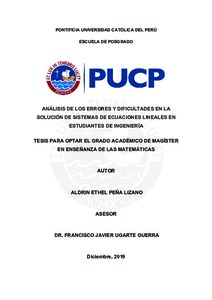| dc.contributor.advisor | Ugarte Guerra, Francisco Javier | |
| dc.contributor.author | Peña Lizano, Aldrin Ethel | es_ES |
| dc.date.accessioned | 2020-01-22T17:12:14Z | |
| dc.date.available | 2020-01-22T17:12:14Z | |
| dc.date.created | 2019 | |
| dc.date.issued | 2020-01-22 | |
| dc.identifier.uri | http://hdl.handle.net/20.500.12404/15638 | |
| dc.description.abstract | Esta investigación tiene por objetivo analizar las concepciones de solución
y conjunto solución que tienen estudiantes universitarios, en un primer curso de
matemáticas, luego de un periodo de por lo menos cinco años alejados de una
institución educativa. Para ello, construimos una prueba diagnóstica tomando en
cuenta los resultados de investigaciones ya realizadas por Ochoviet, Panizza,
Mora, Valencia, entre otros, y la enmarcamos dentro de la propuesta de los
modos de pensamiento de Sierpinska (2000). El primero, llamado sintético
geométrico, se agrupa en las preguntas que muestran graficas de las ecuaciones
del sistema y, a partir de ello, se pide interpretar la solución o conjunto solución.
El segundo modo de pensamiento, llamado analítico aritmético lo asociamos a
las ecuaciones que representan a las rectas y planos, además a todos los
algoritmos y métodos de solución que existen para resolver un sistema lineal de
ecuaciones. El tercer modo de pensamiento, llamado analítico estructural, se
agrupa en preguntas cuyas respuestas son explicadas a través de propiedades,
características y axiomas de un sistema lineal de ecuaciones lineales.
Para nuestro trabajo de investigación recurrimos a identificar los errores y
dificultades en que los estudiantes incurren al estudiar el conjunto solución o
solución de un sistema de ecuaciones lineales, algunos ya observados y
detectados en investigaciones previas y otros no, los cuales los clasificaremos
según Socas (1997).
Del análisis de los datos, observamos que predomina el modo de
pensamiento analítico aritmético; lo que dificulta tener una mejor comprensión
sobre el concepto de conjunto solución de un sistema de ecuaciones lineales y
debido a ello consideramos que se hace necesarios desarrollar ejercicios y
problemas en dicho tema donde puedan transitar los tres modos de pensamiento
de Sierpinska (2000). | es_ES |
| dc.description.abstract | This research aims to analyze the conceptions of solution and set solution that
university students have, in a first course of mathematics, after a period of at least
five years away from an educational institution. To do this, we built a diagnostic
test taking into account the results of research already carried out by Ochoviet,
Panizza, Mora, Valencia, among others, and we framed it within the proposal of
Sierpinska's modes of thinking (2000). The first, called geometric synthetic, is
grouped into the questions that show graphs of the system equations and, from
that, it is asked to interpret the solution or solution set. The second way of
thinking, called arithmetic analytics, is associated with the equations that
represent the lines and planes, in addition to all the algorithms and solution
methods that exist to solve a linear system of equations. The third way of thinking,
called structural analytics, is grouped into questions whose answers are
explained through properties, characteristics and axioms of a linear system of
linear equations.
For our research work we resort to identifying the errors and difficulties that
students incur when studying the set solution or solution of a system of linear
equations, some already observed and detected in previous investigations and
others not, which we will classify them according to Socas (1997).
From the analysis of the data, we observe that the arithmetic analytical mode of
thinking predominates; what makes it difficult to have a better understanding of
the concept of a solution to a system of linear equations and because of this we
consider that it is necessary to develop exercises and problems in this topic
where the three ways of thinking of Sierpinska (2000) can pass. | es_ES |
| dc.language.iso | spa | es_ES |
| dc.publisher | Pontificia Universidad Católica del Perú | es_ES |
| dc.rights | Atribución-CompartirIgual 2.5 Perú | * |
| dc.rights | info:eu-repo/semantics/openAccess | es_ES |
| dc.rights.uri | http://creativecommons.org/licenses/by-sa/2.5/pe/ | * |
| dc.subject | Matemáticas--Estudio y enseñanza | es_ES |
| dc.subject | Solución de problemas | es_ES |
| dc.subject | Análisis vectorial | es_ES |
| dc.title | Análisis de los errores y dificultades en la solución de sistemas de ecuaciones lineales en estudiantes de ingeniería | es_ES |
| dc.type | info:eu-repo/semantics/masterThesis | es_ES |
| thesis.degree.name | Magíster en la enseñanza de las Matemáticas | es_ES |
| thesis.degree.level | Maestría | es_ES |
| thesis.degree.grantor | Pontificia Universidad Católica del Perú. Escuela de Posgrado | es_ES |
| thesis.degree.discipline | Enseñanza de las Matemáticas | es_ES |
| renati.advisor.orcid | https://orcid.org/0000-0001-5071-8924 | es_ES |
| renati.discipline | 199117 | es_ES |
| renati.level | https://purl.org/pe-repo/renati/level#maestro | es_ES |
| renati.type | http://purl.org/pe-repo/renati/type#tesis | es_ES |
| dc.publisher.country | PE | es_ES |
| dc.subject.ocde | https://purl.org/pe-repo/ocde/ford#5.03.01 | es_ES |






